U.S. Department of Transportation
Federal Highway Administration
1200 New Jersey Avenue, SE
Washington, DC 20590
202-366-4000
Federal Highway Administration Research and Technology
Coordinating, Developing, and Delivering Highway Transportation Innovations
|
Research & Technology Transporter This newsletter is an archived publication and may contain dated technical, contact, and link information. |
|
| Publication Number: N/A Date: April 2003 |
Publication Date: April 2003
|
Pavement and bridge designers often specify ASTM Class F or Class C fly ash and silica fume for high performance portland cement concrete (PCC) to improve its strength or durability. The fly ash in concrete consumes the calcium hydroxide content; reduces permeability, shrinkage, and cracking; or minimizes the water needed in the mixture. However, a given fly ash is categorized as Class C or F only by its bulk chemical composition, which may not reflect its reactivity characteristics. Without knowing this information, engineers and planners may be specifying concrete that fails to meet the designated levels of strength or durability. This will lead to decreased longevity of the structure and thus to increased traffic congestion because repairs may be needed sooner.
The Federal Highway Administration (FHWA) advanced research program is evaluating scientifically advanced techniques for classification. They are also working on a new classification system for fly ash based on its reactivity. The research includes studying the pozzolanic activity of fly ash, which is the ability of the silica and alumina components to react with the calcium hydroxide formed during PCC hydration. Advanced characterization methods include elemental analysis by an automated scanning electron microscope to identify the composition of individual particles; x-ray diffraction for the mineralogy and automated glass refractometry-a process of passing light rays through a collection of particles under a microscope to measure how the rays bend at the interfaces of different types of particles - to ascertain the index of refraction of the fly ash's glass content, which is the most reactive component. With this data, FHWA will then model the reactivity of the glassy content by applying glass durability theory, which predicts the rate of reaction with water based on the differing chemical behavior of various groups of elements that make up the glass structure.
In addition, FHWA is collaborating with the National Institute of Standards and Technology to use inelastic and small-angle neutron scattering to measure the reactivity of fly ash after it is mixed in the concrete. Both techniques are nondestructive and involve passing neutrons through a sample to determine its characteristics. In this case, inelastic neutron scattering is used to measure the consumption of calcium hydroxide, while small-angle neutron scattering is used to characterize the microstructure development Past research by FHWA determined that cement mixes containing high-density fly ash tend to have greater pozzolanic activity than mixes containing low-density fly ash.
When the research is complete, FHWA plans to develop computer software that will enable pavement designers and contractors to calculate the optimal proportions of fly ash, silica fume, Portland cement and water for PCC for a particular project. Presenting these results graphically will require data visualization software that can project 4-dimensioanal data on a two-dimensional computer display.
In March 2003, FHWA held a technical seminar at TFHRC on the findings from the fly ash research to date. The seminar presented the preliminary results of the characterization methods applied to two representative fly ashes and the reactivity measurements using neutron scattering. Approaches to using glass durability theory for predicting reactivity were also covered.
For more information, contact:
Richard A. Livingston 202-493-3063 dick.livingston@fhwa.dot.gov
 |
| Scanning electron microscope image of Class C fly ash. Spherical particles are the glassy reactive component. |
According to the Federal Highway Administration (FHWA) Electronic Intermodal Supply Chain Manifest FOT Evaluation Final Report, air transport is the fastest growing freight transportation mode, with volume and revenue projected to double by 2006. While truck-to-air cargo movements grew rapidly, the system for the most part is still regulated by using paper- and telephone-based information exchanges. After September 11, tracking these shipments across a multimodal distribution channel became important to the security of the Nation-especially because freight operators transport large amounts of cargo through passenger planes. The wide use of the Internet and electronic media created a new opportunity to make the freight system more secure and perhaps alleviate bottlenecks and delays during freight movements across the country.
U.S. Department of Transportation agencies used a multimodal approach by cosponsoring an operational test of the Internet-based Electronic Supply Chain Manifest (ESCM) system. ESCM uses electronic manifests, smart cards, and biometric devices to automate the transfer of cargo information from one mode of transportation to another. The two and a half year study compared the efficiency and security of an electronic system against a traditional manual paper-based system. Cosponsors of the study include: U.S. Department of Transportation Office of the Secretary, Intelligent Transportation Systems Joint Program Office, FHWA Office of Freight Management, Federal Aviation Administration, American Transportation Research Institute (ATRI), the City of Chicago, and the State of Illinois.
Results of the study show that implementing the ESCM system could yield substantial time savings of almost a minute and a half per shipment by reducing the time required to find documentation, complete manifests, verify loads, and validate driver sign-offs. The electronic processing of truck drivers at air cargo facilities was 2 to 4 times faster than a manual, paper-based system. ECMS functionality enabled freight operators to view information on cargo custody real-time, making it easy to see cargo locations anywhere in the process.
A recent press release on the project stated that the ESCM system could lead to substantial cost savings ranging from $1.50 to $3.50 per transaction. Although these savings in cost and time appear small, the savings could be considerable when aggregated across all shipments. The operational test report Electronic Intermodal Supply Chain Manifest Field Operational Test Evaluation also indicates that the participants found the system to be easy-to-use and were very satisfied with the ability of ESCM to duplicate necessary business functions. Study reviewers also believe the system will improve operational efficiency if more fully deployed. They further believe that even though the study centered around the trucking and aviation travel modes, companies could use the ESCM technologies for rail and marine shipments as well.
"The first phase of the test primarily focused on providing truck drivers with access to secure cargo facilities at Chicago's O'Hare International Airport using a fingerprint biometric smart card system," says Dan Murray, ESCM project manager and director of research at ATRI. "Recognizing that security vulnerabilities exist farther up the supply chain and that improvements to freight flows improve the entire transportation system, we integrated an electronic cargo management component that provided encrypted data transfers prior to pick-ups and deliveries, and expanded the system to include sites in New York, NY, Toronto, Canada, and Los Angeles, CA."
For complete test information, view the final report at www.its.dot.gov or contact:
Mike Onder 202-366-2639 michael.onder@fhwa.dot.gov
and
Kate Hartman 202-366-2742 kate.hartman@fhwa.dot.gov
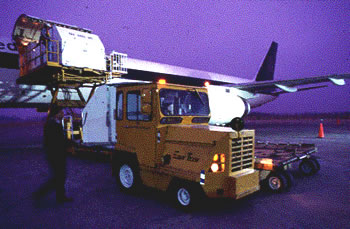 |
| Workers load a plane with cargo. |
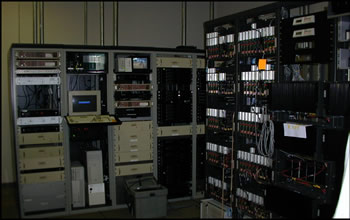 |
| The centralized ESCM system server shown here, used for initial testing, enables authorized personnel to process manifests via the Internet. |
As the transportation infrastructure of the Nation continues to age, many elements will need to be replaced or rehabilitated, including thousands of bridges. According to the Federal Highway Administration (FHWA) National Bridge Inventory, nearly 28 percent of all bridges in the United States are considered deficient and are eligible for replacement and/or rehabilitation.
When the bridges are rebuilt, engineers frequently use prefabricated elements or systems-bridge parts and systems that either are constructed onsite on the ground rather than in the air while the bridge is being built or manufactured offsite and brought in ready for installation. By using prefabricated parts, engineers can reduce the time, cost, and traffic impacts of the construction, increase construction zone safety, and make construction less disruptive to the environment.
In February 2003, FHWA, in cooperation with the American Association of State Highway and Transportation Officials, the Midwest Transportation Consortium, and the University of Missouri-Columbia, sponsored the National Prefabricated Bridge Elements and Systems Conference. Targeting representatives from State departments of transportation, bridge engineers at FHWA, contractors, and materials suppliers, the 3-day event in St. Louis, MO, attracted more than 200 people.
At the conference, experts from around the Nation presented case studies showcasing the successful uses and benefits of prefabricated bridge elements and systems. One expert discussed how the cost of traffic control around bridge projects frequently exceeds the price of the materials and labor needed to replace the bridge. The speaker described a project along I-40 in Oklahoma where the cost of labor and materials to replace a collapsed bridge across the Arkansas River was $11.8 million, while the cost to control traffic and detours around the construction zone was $12 million. The presenter also explained that the higher upfront costs of prefabricated materials can be offset by the amount of money saved by reduced construction times.
Another presentation highlighted a project in San Juan, Puerto Rico, where construction crews were able to minimize traffic delays and reduce construction times by using prefabricated bridge modules, while building four bridges at a congested intersection of a four-lane arterial. Crews completed the first bridge within 36 hours, and construction of each of the other three bridges took only 26 hours. This would not have been possible without prefabricated elements.
Another expert discussed how using prefabricated elements can lead to quality control improvements, because during manufacturing better controls can be exercised since parts are manufactured in a plant (shop).
In addition to hearing case studies, participants learned about several new technologies and construction techniques, including new specifications for high-performance concrete and steel and self-compacting concrete, and contracting procedures that ensure that bridges are built within 1 day and charge high penalties for any delays.
Krishna Verma 202-366-4601 krishna.verma@fhwa.dot.gov
The phrase "think outside the box" is the mantra for transportation professionals searching for new solutions to old problems. Thinking outside the box recently resulted in using two innovative technologies to reduce early surface cracking and pot holes in pavements.
In 1995, engineers at the Washington State Department of Transportation (WSDOT) noticed that the hot mix asphalt (HMA) on several roadways in the State was cracking prematurely due to fatigue or raveling-a process in which pieces of pavement become loose and dislodge from the surface of the road-many years prior to the end of the material's design life. In 1998, engineers at WSDOT discovered the reason by using infrared cameras to show temperature differentials in the HMA during the hauling and laying process. The infrared images showed that when the asphalt mixture was laid down, some areas were significantly cooler than others, leading to areas of lower compaction with large air voids in the cool areas. The result later, was premature cracking or raveling.
By examining the images, the engineers determined that the cool spots form in the asphalt mixtures during transport to the construction sites. WSDOT now can ensure that the HMAconcrete is mixed thoroughly re-mixed and that the temperature is consistent throughout the pavement by using the cameras to identify any remaining thermal segregation while the HMA is being laid. This project represents WSDOT's first use of infrared cameras, and the department now uses them to help extend the life of the State's roadways and to delay the need for rehabilitation or replacement. For more information about the success with the infra-red cameras, contact Kim Willoughby at 360-709-5474 or willouk@wsdot.wa.gov.
In another development, an Australian firm, Pioneer Road Services, found a way to reduce cracking that occurs when pavement is laid down. Unlike a traditional compactor that uses steel rollers, the company's Hot Iron Principle Asphalt Compactor (HIPAC) employs a thick rubber belt wrapped around the steel rollers. Traditional rollers ride on top of the aggregate material in pavements and may not distribute pressure evenly across the mastic-the binder material that surrounds the aggregates in the HMA pavement. HIPAC's rubber belt rides over the pavement and conforms to the shape of the aggregate pieces, placing enough pressure on the aggregate and mastic to bind them and help prevent shear cracking or heat checking. Fewer cracks means that the pavement can better withstand heavy loads, thereby increasing the life of the pavement. HIPAC also achieves compaction in fewer passes than conventional rollers by applying compactive effort the total distance between the front and rear steel rollers for the total length of time it takes the comlactor to pass any point. That is same compactve force, applied uniformily across a lrger foot print for alonger duration. No pushing, on shoving, no supported edges.
Although the Australian technology currently is not in use in the United States, the Federal Highway Administration plans to increase awareness of HIPAC and other innovative compaction improvements so that State and local transportation agencies, private contractors, and pavement engineers will consider using innovation and improved technology to enhance project quality and accelerate construction operations on future projects. For more information about HIPAC, contact Cathy Nicholas at 360-753-9412 or cathy.nicholas@fhwa.dot.gov.
James Sorenson 202-366-1333 james.sorenson@fhwa.dot.gov
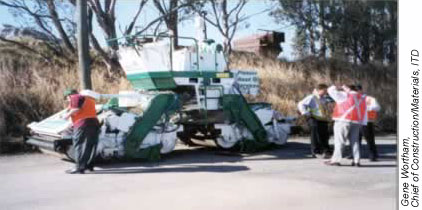 |
| The Hot Iron Principle Asphalt Compactor shown here uses a rubber belt wrapped around steel rollers to ensure even compaction and ultimately to reduce cracking in completed roadways. |
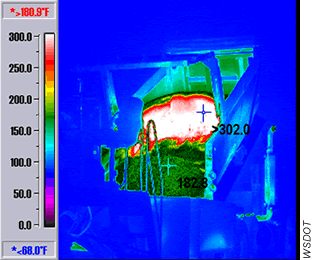 |
| The thermal image above shows temperature differences in asphalt being delivered to the paver. |
Keri Funderburg was the ICF writer for this article.
Congestion on urban freeways and arterials leads to long delays, air pollution, and increased potential for incidents. As the transportation system becomes more sophisticated and complex, transportation professionals must adopt new ways to manage existing systems more efficiently. One tool that engineers use to evaluate and improve congested roadway facilities is COrridor SIMulation (CORSIM).
A new course offered by the Federal Highway Administration (FHWA) National Highway Institute (NHI) introduces engineers to the ins and outs of using CORSIM. The 3-day course, CORSIM Traffic Simulation Model Training (#137022A), helps bring transportation engineers up to speed on this valuable tool and is perfect for those involved in the planning and deployment of intelligent transportation systems (ITS), from the public or private sector and academia.
The CORSIM software tool developed by the FHWA can simulate driver behavior and traffic control conditions on street and freeway networks, determine the impacts of traffic engineering and control strategies, and create visual representations of traffic operations on urban streets and freeways. CORSIM helps determine how engineering and control strategies affect the operational performance of a transportation network, expressed in various measures, such as speed, travel time, volume, and delay. These measures evaluate the effectiveness of an applied strategy on traffic operations and provide a basis for optimizing the strategy.
As the simulation package within the Traffic Software Integrated System (a collection of four software tools used to simulate traffic patterns within complex signal and freeway systems), CORSIM supports a variety of traffic engineering activities such as analyses of signal retiming, major traffic events and their traffic impacts, freeway incidents, stadium operations, and corridor traffic operations. CORSIM software also helps evaluate ITS technologies, including freeway ramp metering, real-time traveler information, and route guidance.
Upon completing the course, participants will be able to:
State departments of transportation and other organizations interested in sponsoring the course must provide microcomputers with Intel® Pentium® 200 megahertz or faster processors; with Windows® 95, Windows NT®, or more recent operating systems; color monitors; hard drives with at least 50 megabytes of disk space; and a minimum of 64 megabytes of random access memory.
To learn more, consult the course catalog on the NHI Web site at www.nhi.fhwa.dot.gov. For scheduling, contact Danielle Mathis-Lee at 703-235-0528 or danielle.mathis-lee@fhwa.dot.gov. For technical information, contact John Halkias at 202-366-2183 or john.halkias@fhwa.dot.gov.
Bud Cribbs 703-235-0526 bud.cribbs@fhwa.dot.gov
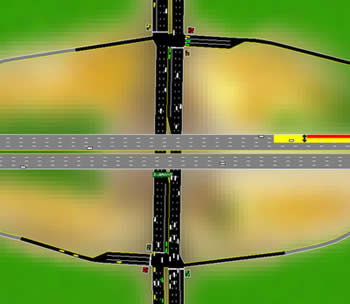 |
| One output from the CORSIM software-often used for public presentations-is an animation sequence that enables users to see what the highway system looks like in operation. During the course, participants learn how to generate, view, and interpret the animations. This snapshot from a sequence shows a diamond interchange with signals at the ramps. |